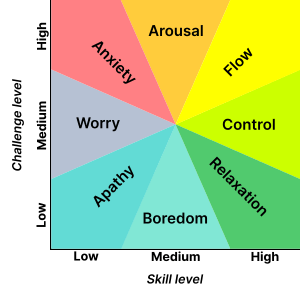Mihaly Csikszentmihalyi facts for kids
Quick facts for kids
Mihaly Csikszentmihalyi
|
|
|---|---|

Csikszentmihalyi in 2010
|
|
| Born |
Mihaly Robert Csikszentmihalyi
29 September 1934 |
| Died | 20 October 2021 (aged 87) Claremont, California, U.S.
|
| Nationality | Hungarian |
| Alma mater | University of Chicago |
| Occupation | Psychologist, academic |
| Known for | Flow (psychology) Positive psychology Autotelic activities |
| Spouse(s) |
Isabella Selega
(m. 1961) |
| Children | 2; including Christopher |
| Scientific career | |
| Fields | Psychology |
| Institutions | Claremont Graduate University University of Chicago Lake Forest College |
| Thesis | Artistic problems and their solutions; an exploration of creativity in the arts. (1965) |
| Doctoral advisor | Jacob W. Getzels |
| Doctoral students | Keith Sawyer |
Mihaly Robert Csikszentmihalyi (born September 29, 1934 – died October 20, 2021) was a famous Hungarian-American psychologist. He is best known for creating the idea of "flow". This is a special mental state where you are completely focused and productive.
He was a respected professor at Claremont Graduate University. He also led the psychology department at the University of Chicago. Before that, he worked at Lake Forest College.
Contents
Early Life and Education
Mihaly Robert Csikszentmihalyi was born on September 29, 1934. His birthplace was Fiume, which is now called Rijeka. At that time, it was part of Italy. His family name comes from a village in Transylvania.
His father was a diplomat for Hungary. After World War II, his family moved to Rome, Italy. When Communists took over Hungary in 1949, his father decided to resign. This meant his family lost their Hungarian citizenship.
To make money, his father opened a restaurant in Rome. Young Mihaly left school to help his family. During this time, he traveled in Switzerland. There, he heard a famous psychologist named Carl Jung give a talk.
Csikszentmihalyi moved to the United States when he was 22. He worked at night to pay for his studies at the University of Chicago. He earned his bachelor's degree in 1959 and his Ph.D. in 1965 from the same university. Later, he taught at Lake Forest College before becoming a professor at the University of Chicago in 1969.
Understanding Flow and Happiness
Csikszentmihalyi is well-known for his studies on happiness and creativity. But he is most famous for his idea of flow. He spent many years researching and writing about this topic.
Martin Seligman, a former head of the American Psychological Association, called Csikszentmihalyi the top researcher in positive psychology. Positive psychology studies what makes people happy and thrive. Csikszentmihalyi believed that true enjoyment comes from choosing to challenge yourself.
What is Flow?

In his important book, Flow: The Psychology of Optimal Experience, Csikszentmihalyi explained his theory. He said people are happiest when they are in a state of flow. This is when you are totally focused on what you are doing. Nothing else seems to matter.
People often call this feeling "being in the zone." It's a great feeling where you are completely involved in an activity. You feel engaged, fulfilled, and skilled. When you are in flow, you often forget about time or yourself.
Csikszentmihalyi told Wired magazine that flow means "being completely involved in an activity for its own sake." He added, "Time flies. Your whole being is involved, and you're using your skills to the utmost."
He described nine parts of achieving flow. These include balancing challenge and skill, clear goals, and getting instant feedback. You also need to focus on the task and feel a sense of control. Time might seem to change, and you lose self-awareness.
To reach a flow state, the task must be just challenging enough for your skills. If it's too easy or too hard, you won't experience flow.
Autotelic Personality
Csikszentmihalyi also studied the autotelic personality. An autotelic person does things because they enjoy them, not for outside rewards. He said these people can find joy in situations others might find difficult. Being curious, persistent, and humble are often part of an autotelic personality.
The Power of Motivation
Much of Csikszentmihalyi's later work looked at motivation. He studied what helps people feel motivated, take on challenges, and succeed. He focused a lot on intrinsic motivation. This is when you do something because you enjoy it, not for a reward.
He found that people who are intrinsically motivated are more likely to set goals. They also enjoy challenges that lead to more happiness. Csikszentmihalyi saw intrinsic motivation as a strong way to improve positive experiences. It helps you feel good and boosts your overall well-being from challenging activities.
He identified a new personality trait called work orientation. This trait includes being achievement-focused and persistent. Students with high work orientation often get better grades. They are also more likely to reach their long-term goals.
Personal Life and Awards
Mihaly Csikszentmihalyi married Isabella Selega in 1961. They had two sons. One is Christopher Csíkszentmihályi, an artist and professor. The other is Mark Csikszentmihalyi, a professor at University of California, Berkeley.
Csikszentmihalyi received many awards for his work. In 2009, he won the Clifton Strengths Prize. He was given the Széchenyi Prize in Hungary in 2011. In 2014, he received the Grand Cross Order of Merit of the Republic of Hungary. He was also a member of important groups like the American Academy of Arts and Sciences.
Mihaly Csikszentmihalyi passed away on October 20, 2021. He was 87 years old and died at his home in Claremont, California.
See also
 In Spanish: Mihály Csíkszentmihályi para niños
In Spanish: Mihály Csíkszentmihályi para niños
- Attention
- Cognitive science
- Creativity
- Experience sampling method
- John Neulinger
- Motivation
- Psychology

